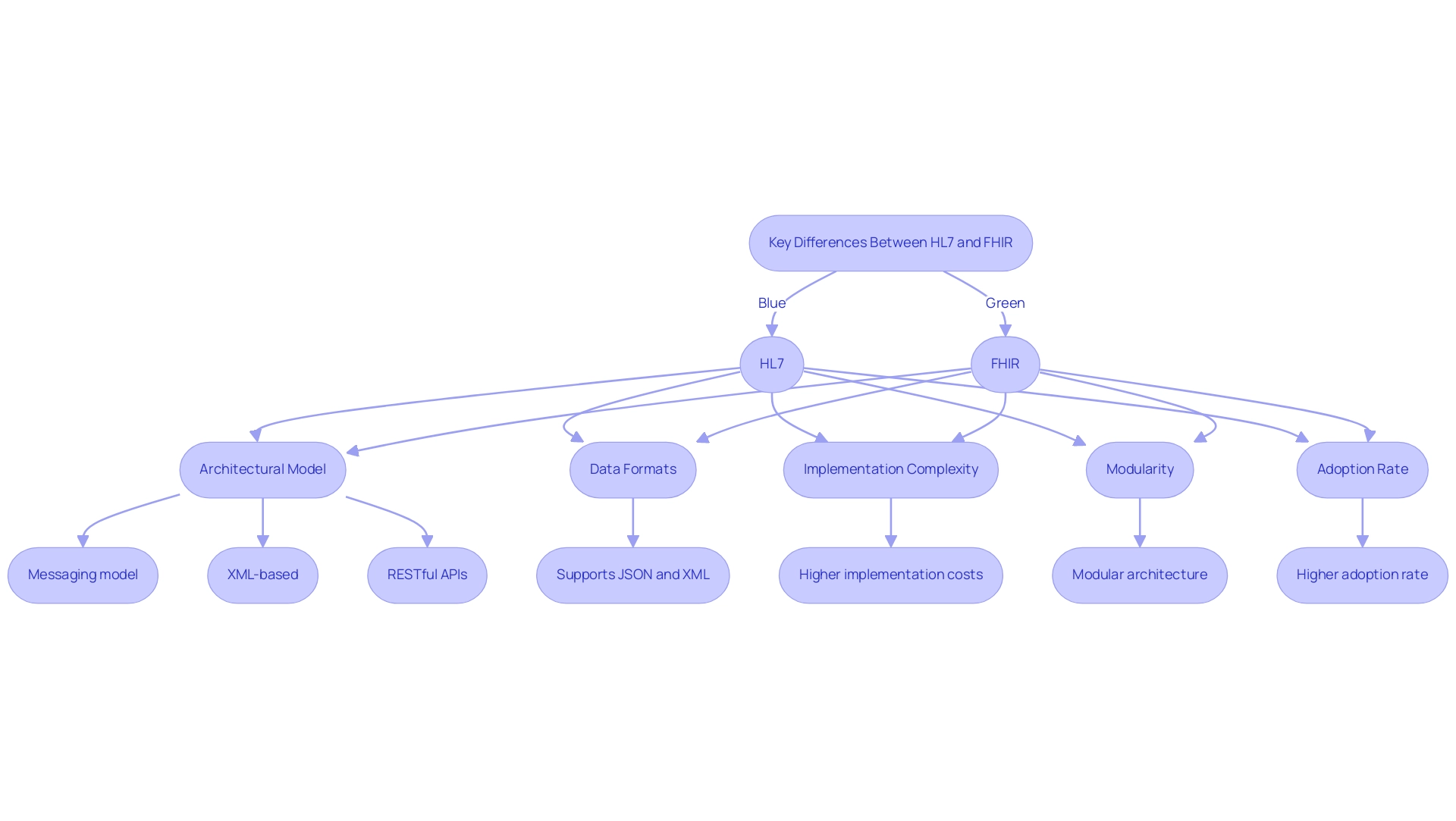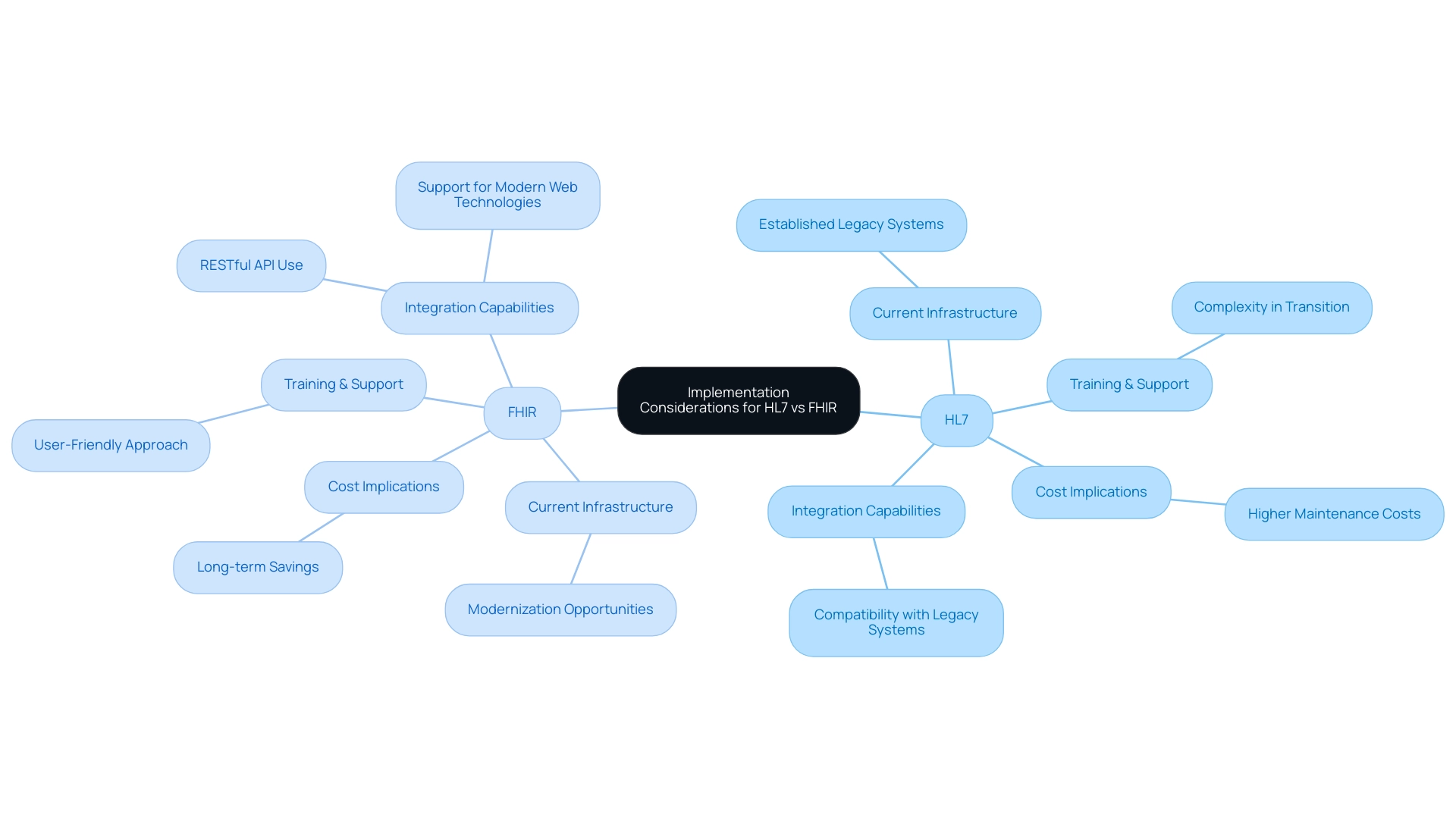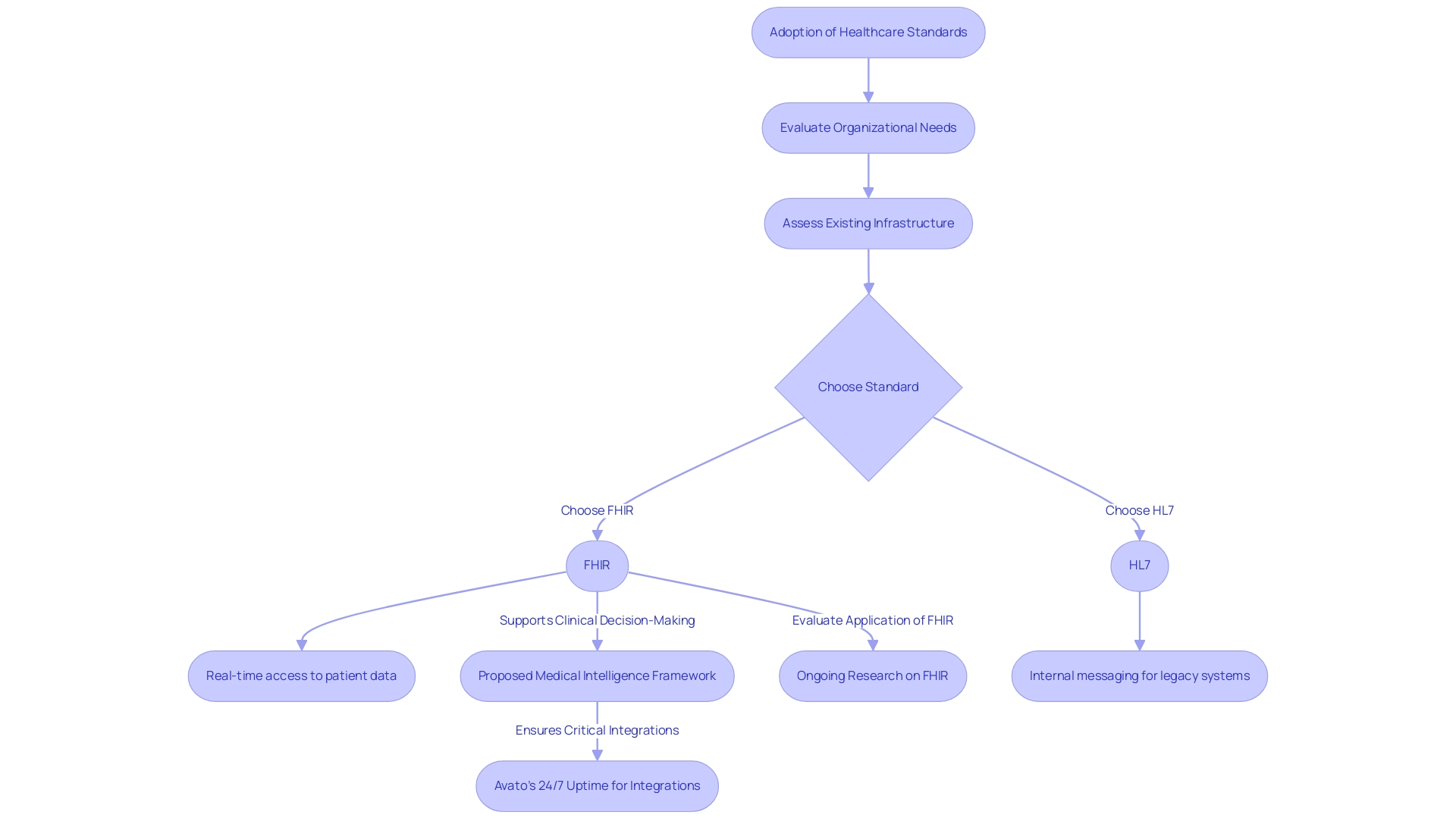Overview
This article provides a critical comparison between FHIR (Fast Healthcare Interoperability Resources) and HL7 (Health Level Seven) to ascertain which standard better meets the evolving needs of healthcare.
- FHIR’s user-friendly design and adaptability emerge as significant advantages, positioning it as a forward-thinking solution.
- Furthermore, FHIR’s modern architecture facilitates easier implementation and interoperability, making it increasingly favored in the healthcare sector.
- In contrast, HL7’s relevance persists primarily within legacy systems.
- As a result, organizations must consider the benefits of adopting FHIR to enhance their healthcare delivery systems.
Introduction
In the dynamic realm of healthcare, the demand for seamless data exchange is more critical than ever. Organizations are increasingly focused on enhancing interoperability and improving patient outcomes, positioning two prominent standards—HL7 and FHIR—as pivotal in this transformation.
- HL7, with its established legacy, offers a robust framework for electronic health information exchange.
- In contrast, FHIR introduces a modern, user-friendly approach that capitalizes on contemporary web technologies.
This article delves into the intricacies of these standards, highlighting their unique features, the challenges they address, and the growing preference for FHIR in today’s healthcare landscape.
With real-world case studies and expert insights, it examines how integration platforms like Avato are paving the way for a more interconnected healthcare ecosystem, ultimately shaping the future of health data interoperability.
Understanding HL7 and FHIR: Definitions and Origins
HL7, or Health Level Seven, represents a set of international standards designed to facilitate the exchange of electronic health information, thereby enhancing the interoperability of health information systems. Founded in the late 1980s, HL7 has progressed considerably, with its most recent versions concentrating on enhancing information exchange efficiency across various medical environments. In contrast, Fast Healthcare Interoperability Resources (FHIR) is a more recent standard developed by HL7 that leverages modern web technologies to address the limitations of its predecessors. This standard was specifically created to be more flexible and user-friendly, addressing the changing requirements of modern medical environments.
Both FHIR and HL7 aim to facilitate the exchange of information in the medical field, yet they approach this objective from different technological perspectives. HL7 standards, while robust, often require more complex implementations, which can pose challenges for integration with modern systems. Conversely, FHIR’s framework encourages user-friendliness and swift implementation, rendering it especially attractive for entities aiming to boost interoperability without significant renovations of current systems.
Recent statistics show that adoption rates of FHIR in the medical field are increasing, with numerous organizations acknowledging its ability to enhance information accessibility and patient care. For example, a notable proportion of medical providers have started adopting FHIR-based solutions, indicating a transition towards more agile and responsive information exchange methods. Real-world instances of health information exchange execution showcase its efficacy in reaching interoperability objectives, with case studies emphasizing successful integrations that have resulted in enhanced operational efficiencies and improved patient outcomes.
In this context, Avato’s hybrid integration platform stands out as a daily operational tool that tackles the challenges of merging isolated legacy systems and fragmented information. Avato, which embodies a deep dedication to architecting technology foundations—reflected in its name derived from the Hungarian word for ‘of dedication’—offers a reliable, future-proof technology stack that empowers businesses to adapt to changing demands. This renders it a crucial tool for organizations maneuvering through the intricacies of medical interoperability, especially in addressing the challenges of FHIR versus HL7 and other standards.
Expert insights emphasize the vital role of both FHIR and HL7, along with alternative standards, in shaping the future of medical interoperability. Industry leaders stress that while HL7 remains fundamental, understanding the distinctions between FHIR and HL7 is crucial for addressing the changing needs of medical information exchange. As organizations navigate the complexities of integrating legacy systems with modern technologies, grasping the strengths and applications of FHIR versus HL7 becomes increasingly vital.
Gustavo Estrada from BC Provincial Health Services Authority noted Avato’s ability to simplify complex projects and deliver results within desired time frames and budget constraints, reinforcing the importance of integration platforms in achieving interoperability goals. Moreover, the risk difference linked to adopting FHIR over HL7 emphasizes the quantitative advantages of modernizing healthcare information exchange, creating a strong argument for its implementation.
Key Differences Between HL7 and FHIR: A Comparative Analysis
The fundamental distinction in architectural frameworks becomes evident when comparing FHIR and HL7. HL7 operates on a messaging model that often necessitates intricate configurations and is predominantly XML-based. This complexity can lead to higher implementation costs and longer development timelines.
In contrast, FHIR leverages RESTful APIs and accommodates various data formats, including JSON and XML, significantly enhancing its flexibility and ease of implementation. This contemporary approach enables medical organizations to adopt new standards more readily, as evidenced by its swift uptake throughout the sector, driven by an increasing focus on interoperability.
Moreover, the modular architecture of FHIR allows for the use of discrete resources that can be manipulated independently, setting it apart from HL7’s more rigid structure. This modularity not only accelerates development cycles but also simplifies integration with modern web applications, making it a preferred choice for organizations aiming for efficient and high-quality information exchange.
Recent evaluations, including the case study titled “Comparative Analysis of FHIR vs HL7,” indicate that while HL7 remains a staple for established systems, FHIR’s flexibility positions it as the leading standard for organizations focused on modernizing their information exchange processes. The case study underscores the structural differences, flexibility, security features, and applications in healthcare, reinforcing FHIR’s advantages.
A hybrid approach, allowing both HL7 V3 and FHIR to coexist, is increasingly being adopted, enabling organizations to leverage the strengths of both standards for effective data exchange. As Gustavo Estrada noted, Avato simplifies complex projects and delivers results within desired time frames and budget constraints. By maximizing and extending the value of legacy systems, Avato’s Hybrid Integration Platform facilitates the connection of both FHIR and HL7, illustrating the effectiveness of solutions in navigating the complexities of FHIR vs HL7.
Additionally, the platform provides real-time monitoring and alerts on system performance, further enhancing operational efficiencies. This strategic unification can lead to improved operational efficiencies and reduced expenses, making it an appealing choice for IT managers in the medical field. Avato, rooted in a commitment to simplifying complex connections, stands as a testament to the dedication to designing technological foundations that enable rich, connected customer experiences.

Why FHIR is Gaining Popularity: Advantages Over HL7
The standard is rapidly gaining traction in the medical field, primarily due to its user-friendly design and seamless integration with modern web technologies. This standard is particularly appealing to medical organizations focused on enhancing patient engagement and optimizing operational efficiency, as it effectively supports mobile applications and cloud-based solutions. A significant advantage of the standard is its emphasis on interoperability, which facilitates improved information sharing across various systems—an essential requirement in today’s medical landscape where integrated care is vital.
Furthermore, FHIR’s alignment with regulatory frameworks, such as the 21st Century Cures Act, solidifies its status as a preferred option for medical data exchange. By 2025, it is projected that 98% of U.S. hospitals will adopt FHIR-based interoperability, indicating a substantial shift towards this standard. In regions like Latin America and Africa, although adoption rates remain lower—with Brazil at approximately 30% and South Africa around 20% in public health establishments—there is a growing recognition of its potential to transform service delivery.
Real-world examples further underscore the framework’s impact on patient engagement. For instance, the HTI-1 ruling aims to enhance medical interoperability, urging organizations to comply with standards. This ruling is expected to improve information accessibility and patient outcomes, making it imperative for healthcare organizations to adapt.
As the standard continues to be explored in sectors such as insurance, pharmaceuticals, and telemedicine, its role in advancing data sharing and analytics becomes increasingly clear. Gustavo Estrada, a client at BC Provincial Health Services Authority, stated, “Avato has simplified intricate projects and provided outcomes within preferred timelines and budget limitations,” highlighting the effectiveness of modern standards in fostering connections and Avato’s dedication to transforming outdated systems into efficient, cost-effective solutions.
Tony LeBlanc from the Provincial Health Services Authority also noted, “Good team. Good people to work with. Extremely professional. Extremely knowledgeable,” further reinforcing Avato’s commitment to excellence in integration solutions.
While the standard presents numerous benefits, it is crucial to consider the comparison of FHIR vs HL7. The contemporary architecture and focus on web standards offer a more adaptable and effective approach for data exchange when analyzing FHIR vs HL7, in contrast to HL7’s traditional methods. This momentum is echoed by leaders in the medical field who recognize the advantages of FHIR vs HL7, particularly in promoting a more connected and responsive ecosystem.
Avato’s hybrid integration platform plays a pivotal role in this transformation, ensuring secure system integration for banking, medical, and government sectors, ultimately enhancing business value and future-proofing operations. Founded by a group of dedicated enterprise architects, Avato is committed to architecting the technological foundation necessary to power rich, connected customer experiences.
Interoperability Challenges in Healthcare: How FHIR Addresses Them
Interoperability continues to present considerable challenges in the medical field, primarily due to the presence of diverse systems and inconsistent formats. The Fast Healthcare Interoperability Resources (FHIR) standard effectively addresses these challenges by providing a standardized framework that simplifies information exchange across various platforms. By utilizing RESTful APIs, FHIR facilitates real-time data access and sharing, which is essential for coordinated patient care.
Moreover, FHIR’s resource-based approach allows providers to retrieve specific data elements without the need to navigate through complex messaging protocols. This streamlined access not only enhances operational efficiency but also significantly improves patient outcomes by ensuring that professionals have timely access to critical patient information.
Statistics reveal that 74% of hospitals have reported the capability to integrate information into their Electronic Health Records (EHRs), highlighting a growing trend towards improved interoperability. This progress is crucial, especially in light of existing policy initiatives aimed at expanding interoperability, such as the national effort stemming from the Cures Act called TEFCA (Trusted Exchange and Common Agreement Framework). However, misalignment with operational needs remains a barrier, underscoring the necessity for a user-centric design approach in health information technology development.
Avato, with its dedicated hybrid connection platform, plays a vital role in addressing these interoperability challenges. By unlocking isolated assets and facilitating business value generation, Avato ensures that medical providers can effectively utilize FHIR to improve information sharing and operational results. The platform’s distinct capabilities, such as seamless integration with existing systems and support for various information formats, position it as a superior solution in the context of FHIR vs. HL7, as traditional HL7 standards can be more complex and less flexible.
Furthermore, the significance of regulatory compliance and security audits cannot be overstated; regular checks are essential to ensure that modernized systems meet all regulatory requirements, thereby fostering trust and reliability in medical information exchange.
Expert opinions emphasize that collective action from providers, patients, technology developers, and regulatory bodies is crucial to achieving true interoperability. For instance, a recent study on policy impacts revealed that regulations like the 42 CFR Part 2, which governs substance abuse confidentiality, hinder interoperability between behavioral health providers and other medical entities. Aligning these regulations with HIPAA guidelines is considered crucial for improving data sharing and continuity of care, especially in tackling public health challenges like the opioid crisis.
In conclusion, this standard not only addresses interoperability issues but also plays a significant role in enhancing healthcare data sharing efficiency, ultimately resulting in better patient care and operational outcomes. Avato’s dedication to designing the technology framework needed for rich, connected customer experiences further strengthens its status as a leader in hybrid solutions.
Implementation Considerations: Adopting HL7 vs. FHIR
When evaluating the implementation of FHIR versus HL7, organizations must conduct a thorough assessment of their current infrastructure and integration capabilities. HL7 may be more suitable for entities with established legacy systems that already utilize HL7 messaging standards. In contrast, FHIR provides a more adaptable and future-ready solution for those seeking to modernize and enhance interoperability.
Notably, FHIR’s architecture is designed to be simpler, which often translates to reduced implementation time and resource requirements. This efficiency is further enhanced by the standard’s compatibility with contemporary development practices, facilitating easier adoption for developers.
Avato, with its dedicated hybrid unification platform, plays a crucial role in simplifying the connection of disparate systems, thereby enhancing business value. The platform’s design aligns well with a user-friendly approach, which can significantly lower the learning curve for both developers and healthcare staff, facilitating smoother transitions and quicker adoption. Avato’s hybrid connection platform directly addresses the challenges presented by both FHIR and HL7, equipping organizations with the essential tools to navigate these standards effectively.
As organizations navigate these choices, they should also consider the cost implications of adopting either standard. While HL7 may incur higher costs associated with maintaining legacy systems, the modern approach can lead to long-term savings through improved interoperability and reduced complexity. Avato’s strategic partnerships, particularly with Red Hat, further enhance its integration solutions, allowing for a more robust and flexible approach to hybrid integration.
Training and support considerations are also critical in this decision-making process. Real-world examples illustrate the challenges and benefits of implementing the standard. For instance, medical organizations that have transitioned to a new standard have reported improved interoperability possibilities, especially in electronic health record (EHR) systems and mobile applications.
The implementation of RESTful APIs in medical data exchange has streamlined integration efforts, enabling broader adoption across diverse technology initiatives. As Gustavo Estrada from BC Provincial Health Services Authority noted, Avato simplifies complex projects and delivers results within desired time frames and budget constraints, which is particularly relevant when considering the implementation of healthcare standards.
Furthermore, FHIR encourages interoperability possibilities and is increasingly adopted in EHR systems, mobile applications, and medical technology initiatives. The case study titled “Advantages of FHIR vs HL7” highlights how this standard was developed to address the complexities of earlier HL7 versions, offering a more user-friendly and flexible approach for health information interoperability. Additionally, both HL7 and FHIR share similarities, such as being constructed around reusable code segments and providing forward/backward compatibility, which assists interoperability in medical systems.
As such, organizations must carefully consider these factors when determining the most suitable standard for their specific needs. Moreover, the cost-saving advantages of schemas in information management and integration cannot be overlooked, as they significantly reduce the financial impact of errors caught at various stages of handling.

Real-World Applications: Case Studies of HL7 and FHIR in Action
Many medical organizations have effectively adopted standards to enhance their information exchange capabilities. For instance, a sizable hospital system embraced the Fast Healthcare Interoperability Resources (FHIR) standard, significantly improving patient information sharing across its various departments. This advancement has led to better care coordination and reduced administrative burdens. The implementation not only enabled real-time access to patient data but also greatly minimized the time spent on data entry and retrieval, showcasing its potential to transform medical workflows.
Conversely, some organizations continue to rely on HL7 for specific use cases, particularly for internal messaging between legacy systems. A regional medical provider, for example, utilized HL7 to maintain communication between its older electronic health record (EHR) systems, ensuring that critical patient information remained accessible despite the challenges posed by outdated technology. This underscores HL7’s enduring relevance in environments where legacy systems are prevalent.
These case studies emphasize the necessity of evaluating organizational needs and existing infrastructure when choosing between FHIR and HL7. As the medical landscape evolves, the incorporation of these standards can significantly impact operational efficiency and patient care outcomes. Furthermore, ongoing research indicates that while the standard enhances the fairness of datasets, it may not be suitable for all types of information, necessitating further assessment of its application across diverse healthcare environments.
For example, a case study focusing on prostate cancer treatment monitoring highlighted the need for centralized monitoring of PSA levels to improve early detection of disease relapse. This illustrates the practical implications of effective data coordination.
In this context, Avato’s commitment to streamlining complex projects is evident through its hybrid connection platform, designed to address the challenges associated with both HL7 standards and other healthcare data formats. As noted by Gustavo Estrada, Acting Provincial Director at BC Provincial Health Services Authority, “Avato enabled us to align the outcomes we wanted to achieve in the time frame and price point we were targeting.” This statement reflects Avato’s role in transforming legacy systems and delivering cost-effective solutions.
Additionally, Avato’s platform provides real-time monitoring and alerts on system performance, ensuring that essential connections are maintained effectively. The proposed medical intelligence framework aims to integrate data access and support clinical decision-making across specialties, aligning with the objectives of both HL7 and FHIR. Ultimately, the decision to adopt FHIR or HL7 should be guided by a comprehensive understanding of each standard’s strengths and limitations in relation to specific organizational goals, with Avato ensuring 24/7 uptime for critical integrations to support these initiatives.

The Future of Healthcare Standards: Trends and Innovations in HL7 and FHIR
The future of medical standards stands on the precipice of a transformative shift, with Fast Healthcare Interoperability Resources at the forefront of enhancing connectivity. As regulatory pressures mount and the demand for integrated care intensifies, the adoption of this standard is poised for significant acceleration. A prominent trend is the convergence of artificial intelligence and machine learning with application programming interfaces, which will enhance data analytics capabilities and empower medical organizations to extract actionable insights from their data.
This shift is critical, particularly as over 70% of C-suite executives in health systems prioritize the enhancement of operational efficiencies and productivity by 2025, amidst challenges such as constrained budgets and staff shortages. Alicia Janisch, Vice Chair and US Health Care Sector Leader, underscores the importance of these trends, asserting that organizations must adapt to maintain competitiveness. Concurrently, HL7 is undergoing continuous evolution, with regular updates designed to bolster its relevance in a swiftly changing medical landscape. Organizations must remain vigilant regarding these developments to ensure they remain competitive and compliant.
The integration of FHIR and HL7 standards transcends mere technical requirements; it embodies a strategic imperative for service providers striving to adeptly navigate the complexities of modern medical delivery, particularly in the context of fhir vs hl7. As highlighted in Deloitte’s Health Care Sector Insights, health system leaders are concentrating on driving efficiencies and enhancing productivity while adapting to shifting consumer preferences and expectations. As the industry progresses, the focus on interoperability and innovative solutions will be pivotal in shaping the future of medical standards.
Moreover, Avato’s dedicated hybrid platform plays an instrumental role in this transformation, ensuring seamless and secure data connectivity while empowering businesses to future-proof their operations through effective connectivity strategies. Avato’s unwavering commitment to guaranteeing 24/7 uptime for critical integrations emphasizes the importance of reliability in healthcare integration, aligning with the focus on operational efficiencies and productivity.
Conclusion
The exploration of HL7 and FHIR reveals their critical role in enhancing healthcare interoperability. HL7, with its rich history, provides a foundational framework for electronic health information exchange; however, it often presents complexities that challenge modern integration efforts. In contrast, FHIR emerges as a transformative standard, leveraging contemporary web technologies to facilitate accessible and efficient data sharing. Its user-friendly architecture promotes rapid deployment, making it increasingly attractive to healthcare organizations aiming to improve patient outcomes and operational efficiency.
The rising adoption of FHIR underscores a significant shift within the healthcare landscape, as evidenced by real-world case studies demonstrating its effectiveness in streamlining data sharing. Organizations are recognizing FHIR’s potential not only to enhance interoperability but also to align with regulatory demands, such as the 21st Century Cures Act. Furthermore, the integration capabilities of platforms like Avato are pivotal in bridging the gap between legacy systems and modern standards, ensuring that healthcare providers can navigate the complexities of data exchange seamlessly.
As the industry continues to evolve, the importance of interoperability becomes even more pronounced. The integration of FHIR and HL7 offers organizations a strategic advantage, enabling them to adapt to the changing demands of healthcare delivery. By embracing these standards, healthcare providers can enhance data accessibility, improve patient care, and ultimately transform the healthcare ecosystem for the better. The future of healthcare interoperability is bright; with the right tools and strategies in place, organizations are well-positioned to thrive in this dynamic environment.

